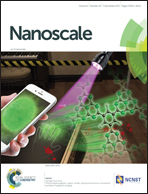Defects by design: synthesis of palladium nanoparticles with extended twin defects and corrugated surfaces†
Abstract
Recent catalytic work has highlighted the importance of grain boundaries in the design of highly active catalyst materials due to the high energy of atoms at strained defect sites. In addition, undercoordinated atoms have long been known to contribute to the catalytic performance of metal nanoparticles. In this work, we describe a method for deliberately increasing the coverage of defect boundaries and undercoordinated atoms at the surfaces of well-defined, symmetric palladium nanoparticles. Careful control of the competitive interactions of chloride and bromide ions with the surface of twinned palladium nanoparticles is used to drive the growth of fin-like structures to extend the area of exposed twin boundaries while also inducing corrugation at the particle surface to add further undercoordinated sites. Mechanistic studies show surface passivation by bromide and etching by chloride in the presence of a low concentration of surfactant to be the key factors that tailor the surface of these nanoparticles, while the internal defect structure is controlled by reaction kinetics. Importantly, these basic principles of competition between surface passivation and etching as well as kinetic control of twin structure are not unique to palladium, and thus this method has the potential to be extended to the enhancement of surface defect density for nanoparticles composed of other catalytically relevant metals.



 Please wait while we load your content...
Please wait while we load your content...